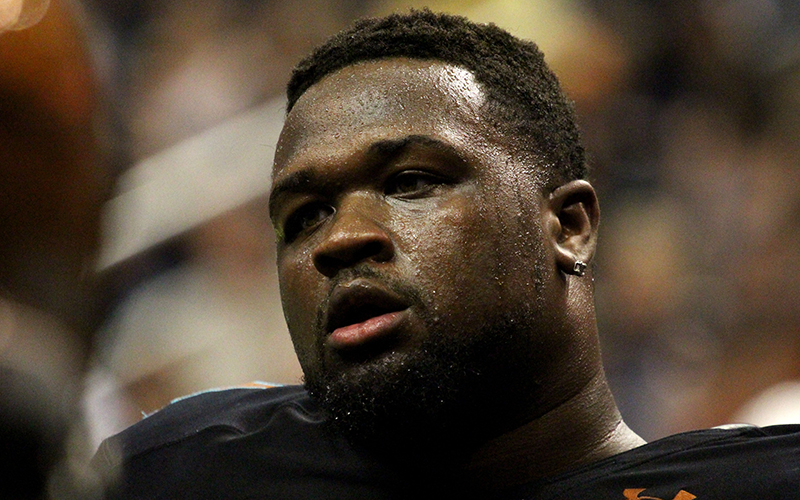
Because of the intense heat, linebacker Ryan Langford and his Arizona Rattlers teammates take frequent water breaks during outdoor practices. (Photo by Matthew Andujo/Cronkite News)

Although defensive lineman Lance McDowell and the Rattlers play inside, their practices are outdoors. They could be playing into next month. (Photo by Kynan Marlin/Cronkite News)
MESA – Of all the major professional teams in Arizona, few have it as tough as the Arizona Rattlers when it comes to practicing in the heat.
The Suns, Mercury and Coyotes do their work indoors. The Diamondbacks venture outside, but usually just during spring training. Only the Cardinals can relate.
“At first it was more of a mindset,” Rattlers offensive lineman Lamar Mady said. “(In) 2016 when I came here, that’s probably the hottest I’ve ever been in my life. … I was like, ‘People really live out here?'”
The Rattlers, who finished the regular season 14-0 and play an Indoor Football League semifinal playoff game Saturday against the Nebraska Danger at Gila River Arena, start competition in late February and will end in July if they advance to the title game. Water is plentiful and trainers are on hand at their practice facility in Mesa as temperatures soar.
And they do. Among cities with populations of at least 10,000, Phoenix is the hottest in the United States, according to a report by 24/7 Wall St. The study was based on the number of 90 degree-plus days, and Phoenix averages 169 of them. Our average midsummer high is 106.1, according to the National Oceanic Atmospheric Administration.
Summer conditions are not for the faint of heart. In 2017, 155 people in metro Phoenix died from heat-related illness, according to a Maricopa County report.
Staying healthy and hydrated is key, team officials said.
“You got to hydrate, you got to eat,” defensive lineman ChrisMcAllister said. “You really got to take care of yourself out here. … You have to do the little things to perform every day and be a pro. It does make you better.”
Team practices are typically held in the morning, with players often at the facility from from 7 a.m. to noon. It’s not as hot as it will be in the afternoon.
Survival is not just a physical issue.
“Me getting that year under my belt, me being out here to compete in the sun and really see where my mental stability was, it helped me,” Mady said. “If you have the mental stability, you can get over it.”
Mady practices in long sleeves and tights, something he has done since he was a member of the NFL Oakland Raiders, and believes that helps keep his body temperature down.
McAllister dealt with the heat growing up in Converse, Texas, but says the dry heat can be misleading when practicing.
“You don’t really sweat too much,” he said. “You have to be ready mentally and your body has to be ready.”
But the dry heat also can be an advantage, said Andrew Grundstein, a professor in the department of geography at the University of Georgia who has studied heatstroke.
“In the Southeast, the temperatures can get pretty high but the humidity is really what really makes it harder for sweat to evaporate and that short circuits your cooling mechanism,” he said.
“When you are out in the Phoenix area and more of a hot-dry environment, it’s dry so the sweat can readily evaporate so your cooling mechanism works really well.”
Still, McAllister said, the heat is not to be taken lightly.
“Take the time to foam roll and cold tub and you got to be in the weight room,” he said. “You’ve got to be in the training room. You’ve got to drink water. Everything that they taught you in college and high school, you have to keep it with you all the way through, especially out here or you aren’t going to make it.”
All that practicing in the heat can help at crunch time. Of the 10 teams in the IFL, seven are in the northern United States or Midwest. The average highs and lows in Bismark, North Dakota, home of the league’s Bucks, is 78 and 52 degrees, respectively, according to the National Oceanic Atmospheric Administration.
“Mentally it helps us,” Mady said. “Mentally it gives us the push we need when it comes to the game as far as being in shape and (our) bodies being good. If you take care of yourself, while you are adjusting to it, it makes you a better player at the end.”
Follow us on Twitter.